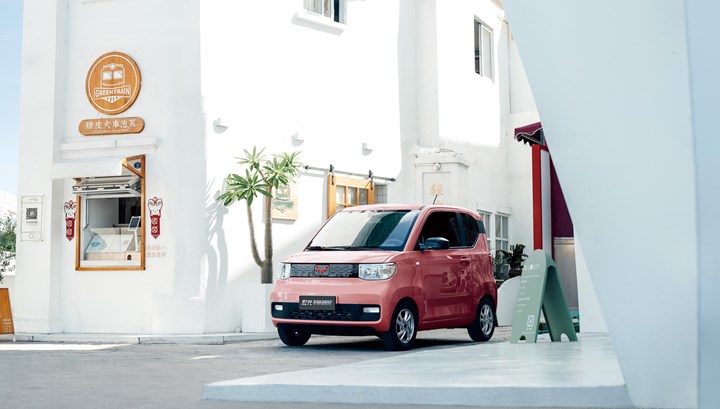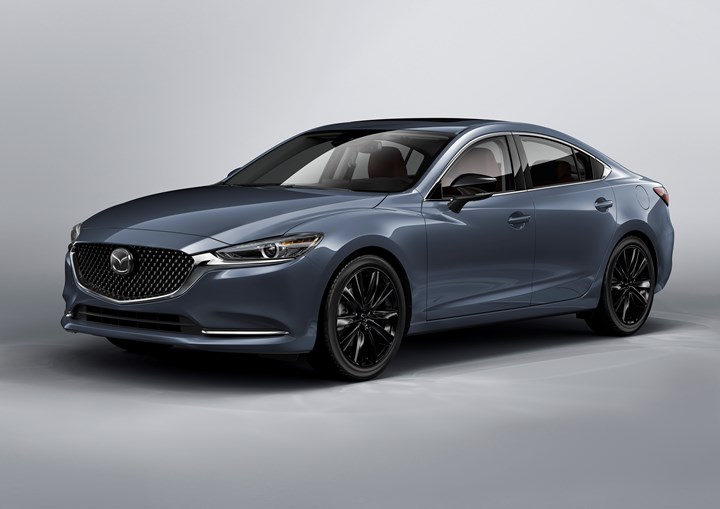On Military Trucks, Euro Car Sales, Mazda Drops and More
Did you know Mack is making military dump trucks from commercial vehicles or that Ford tied with Daimler in Euro vehicle sales or the Mazda6 is soon to be a thing of the past or Alexa can be more readily integrated or about Honda’s new EV strategy? All that and more are found here.
#hybrid #electronics
This week On Automotive
- Mack Making Military Truck on New Line
- Infiniti QX60 Japanese Design Cues
- Somewhat Curious Q1 Euro Sales Numbers
- One More Inovev Fun Fact
- Gloom-Gloom Mazda will discontinue CX-3 and Mazda6
- Hey, Belchfire, Turn Up the Volume
- Honda Prologue Continues a Problem
- Best, Simplest Description of LiDAR
///
Mack Making Military Truck on New Line

Mack starts with a commercial version of the truck and then transforms it for military use. (Image: Mack Trucks)
One of the ways to keep defense spending for vehicles in check (relatively speaking, that is) is for existing consumer vehicles to be engineered to meet the rigorous demands of the military.
One example is the Chevy Colorado ZR2—which could conceivably be in your driveway right now—that is transformed by GM Defense to the U.S. Army Infantry Squad Vehicle (ISV).
And there is the Mack M917A3 Heavy Dump Truck (HDT), which has gone into production at the Mack Experience Center in Allentown, PA, after a $6.5-million investment in a dedicated line.
Solid Foundation
The HDT is based on the civilian Mack Granite, which, according to the company is “one of the top-selling vocational trucks in North America.”
Previously they started the build of the truck at the Mack Lehigh Valley Operations then shipped it to the Mack Experience Center for final assembly.
“The investment to create a dedicated HDT product line at the Mack Experience Center will increase production efficiencies.”—David Hartzell, president, Mack Defense.
Toughened
The truck is equipped with heavier-duty rear axles, all-wheel drive, increased suspension ride height. And armor.
It is powered by a Mack 13-liter inline six that produces 440 hp. It is mated to an Allison six-speed automatic.
The GVW is 94,500 pounds.
Yes, heavy duty.
///
Infiniti QX60 Japanese Design Cues

The Infiniti QX60 design is predicated, in part, on some Japanese design elements. (Image: Infiniti)
Alfonso Albaisa, senior vice president for Global Design for Nissan Motor Co., says that when developing the 2022 Infiniti QX60 the team was inspired by Japanese design.
You might not notice:
- Headlamp design is influenced by kimono folds
- The grille shapes are inspired by the folding of paper of origami
- The pattern of the leather-appointed seats is guided by the way ripples form when a pebble is dropped in a pond
And speaking of an exterior color that is exclusive to the three-row SUV, head of Infiniti Design Taisuke Nakamura said: "The QX60's exclusive and expressive Moonbow Blue captures our hearts and references the silence in the full-moon light on a humid summer evening. Special pigments allow color highlights to shift based on the viewing angle on a spectrum that ranges from purple through to green that delivers a sense of mystique.”
Turns out that summer in Japan is rather humid, with an average relative humidity of about 74% from June through September.
The QX60 is produced. . .in Smyrna, Tennessee.
///
Somewhat Curious Q1 Euro Sales Numbers
In the first quarter of 2021 there were 3,619,749 light vehicles sold in Europe.
Stellantis accounted for 854,151 of them, giving the company—which consists of Abrath, Alfa Romeo, Chrysler, Citroen, Dodge, DS, Fiat, Fiat Professional, Jeep, Lancia, Maserati, Opel, Peugeot, Ram, and Vauxhall—24% of the market. Which makes it number-one.
VW is in second place, with 23% of the market.
But numbers lower on the list from market research firm Inovev are somewhat more interesting.
For example:
- Ford: 7%
- Daimler: 7%
That’s right, Dearborn-based Ford has as much of the Euro market as Stuttgart-based Daimler (don’t think: “Well, Mercedes vehicles aren’t mass-market like Ford products.” That may be the case in the U.S., but in Europe you’re likely to get a C Class taxi.)
And:
- BMW: 6%
- Hyundai-Kia: 6%
- Toyota: 6%
It is worth noting that Inovev crunched the numbers for 2020 sales and determined that of the top-10 European markets, Germany is the country where people buy more locally produced vehicles—35%--than anywhere else in the region.
Of course, there are Volkswagen, Daimler and BMW, so that accounts for a whole lot.
///
One More Inovev Fun Fact

This diminutive EV, the Hong Guang, has proven to be a sales smash. (Image: GM Wuling)
The Chinese passenger car market in Q1 was huge, up 76.6% compared to Q1 2020.
GM-Wuling, which Inovev says has had a “descending trend. . .for several years,” bounced back significantly: a 260% increase.
The reason? Inovev credits the Hong Guang EV.
The what?
Hong Guang MINI EV: A Primer
GM’s Wuling brand introduced the four-seat vehicle in July 2020.
The “MINI” in its name is absolutely descriptive.
The car is 115 inches long, 59 inches wide, 64 inches high and has a wheelbase of 76 inches.
To put that into context: the Fiat 500, whose cuteness couldn’t overcome its smallness, is 144 inches long, 64 inches wide, 50 inches high and has a wheelbase of 91 inches.
The Hong Guang MINI EV produces 17 hp (13 kW) of power.
To stick with the Fiat 500 comparison: the Fiat 500e (the electric variant) produced 111 hp (83 kW).
The Hong Guang has a top speed of 62 mph and a range of 106 miles.
The starting MSRP: RMB 28,800 (~$4,500).
Stylin’
My colleague John McElroy says of the Hong Guang: “It isn’t a car as much as it is a fashion statement.”
Clearly that fashion statement has legs.
///
Gloom-Gloom

The Mazda6, Carbon Edition. (Image: Mazda)
“As consumer interests continue to evolve, Mazda will discontinue CX-3 and Mazda6 for the 2022 model year for the US market. Although these two vehicles will be leaving our lineup in the US, we are proud of the performance, design, quality, and safety they contributed to our brand.”—Mazda North American Operations statement, May 21, 2021
The CX-3 is a subcompact crossover. The Mazda6 is a midsize sedan.
The CX-3 discontinuation is a surprise because crossovers of all dimensions seem to be ever-increasing in the market, though for some reason that hasn’t been the case for the CX-3.
And while the midsize sedan market is about as energized as the static electricity generated by combing one’s hair, it is a disappointment that the Mazda6 is exiting because it is a vehicle with a lot of positive character.
Gen Four
This is the fourth generation of the Mazda6. The first ran for model years 2003 to ’08, the second 2009 to ’13, the third 2014 to ’17, and the current debuted in model year 2018.
At that time Mazda chronicled the development of the vehicle and it includes a passage:
“Mazda believes that there are still people who care about their cars. There always will be. That is why the idea of the car as a transportation tool with no soul and no passion could not be further from the cars Mazda builds today.”
I recently had the opportunity to spend time in a Mazda6 Carbon Edition. It has a turbocharged four that delivers 250 hp and 320 lb-ft of torque with 93 octane (or 227 hp and 310 lb-ft with 87 octane, which goes to show you how there can be a notable difference) mated to a six-speed automatic (which seems to be the only old-timey think about the car).
As a special edition it has a special exterior color—Polymetal Gray.
There are a black rear lip spoiler and black sideview mirror caps. The wheels are 19-inch black metallic. The interior has red leather and red stitching.
And it has the array of tech—from the 8-inch color touch screen through which you can access your Android Auto and Apple CarPlay to the safety tech, like radar cruise control, city braking support with pedestrian protection and collision warning, etc., etc., etc.
How Does This Happen?
The astonishing thing to me is that this is a solid, stylish fully featured midsize sedan, the kind of thing that one would be happy to have in one’s driveway, a car that has a base MSRP of $32,800 and came all-in (including options in the form of a $400 navi SD card and a $100 carpet cargo mat) at $34,245, and yet it is going away.
Too bad, indeed.
///
“Hey, Belchfire, Turn Up the Volume”

Alexa is being made more accessible to OEMs thanks to a development involving Continental and Elektrobit. (Image: Continental)
Not that long ago, if a vehicle didn’t offer Apple CarPlay or Android Auto, many people took it off of their possible purchase list.
Amazon Alexa is like that now.
Continental and Elektrobit have announced they’ve managed to integrate Alexa Custom Assistant into Continental’s Cockpit High Performance Computer.
About this, Jens Brand, head of Human Machine Interface, Continental North America, said:
“Working together with Amazon, we enable automakers to create world-class customized voice AI experiences that maximize resources and enhance the customer experience.”
A simple read:
A given OEM has the possibility of getting its “own” (as in it can put its name in the command) voice activated assistant up and running more easily—Ned Curic, vp of Alexa Auto, described it as “reducing the burden of building and maintaining the core capabilities of an intelligent assistant” (probably not a core competency of most OEMs)—thanks to this collaboration.
///
Honda Prologue Continues a Problem

(Image: Honda)
“While we haven’t been perceived as leaders in recent years, we’re not neophytes in the electrified space.” That’s Dave Gardner, executive vp, American Honda Motor Co.
And to establish its EV cred, Gardner ticks off the EV Plus, Honda Insight Hybrid (intro in U.S. 2009), the FCX and FCX Clarity (fuel cells), the Fit EV, the Clarity (electric, plug-in and fuel cell). There have been plenty of hybrids along the way.
The problem: Honda has never gotten recognition for its hybrids the same way that, say, Toyota has. The Fit EV had an underwhelming range of 82 miles. The electric Clarity went out of production last year and the other two will be stopped by the end of this year.
So, no, not a leader.
Gardner has announced the companies “first volume” battery electric, the Prologue, a crossover, which is coming in 2024.
The problem, 2: This is the vehicle that will be based on the flexible global EV platform developed by General Motors. They will be manufactured by General Motors for Honda.
So how does this help establish electrified leadership for Honda?
It may look like a Honda. It may drive like a Honda. But is is a Honda EV?
///
Best, Simplest Description of LiDAR

(Image: Continental)
“Photons physically touching objects.”-- Shanvir Dhinsa, Field Application Engineer team lead, AEye
RELATED CONTENT
-
Cobots: 14 Things You Need to Know
What jobs do cobots do well? How is a cobot programmed? What’s the ROI? We asked these questions and more to four of the leading suppliers of cobots.
-
GM Develops a New Electrical Platform
GM engineers create a better electrical architecture that can handle the ever-increasing needs of vehicle systems
-
On Fuel Cells, Battery Enclosures, and Lucid Air
A skateboard for fuel cells, building a better battery enclosure, what ADAS does, a big engine for boats, the curious case of lean production, what drivers think, and why Lucid is remarkable


.jpg;width=70;height=70;mode=crop)






